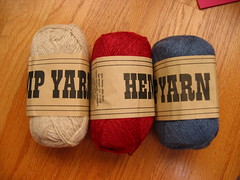 Image by lux2night via FlickrBy Adrian Desbarats
Image by lux2night via FlickrBy Adrian DesbaratsIn Part I of this series, we discussed the early history of hemp clothing production and how hemp products of some kind existed in just about every culture world wide. We discussed the many benefits of this fibre which made it easy to understand why the fibre reached such dominance in world history.
But during the twentieth century, production began a steady decline and by the 1990s, hemp production was but a mere fraction of its peak in 1966. But what happened? How could a fibre with so many benefits decline so sharply, especially considering other natural fibres such as cotton which did not share a similar fate?
By the early twentieth century, the development of the steam engine and the diesel engine ended the age of commercial sailing ships. The production of iron and steel for cable and ships' hulls further eliminated natural fibres in marine use.
The end of global demand for canvas sails and decline in demand for rope certainly put a dent in hemp production but it isn't the whole story. Many argue that once polyester and nylon came on the scene in the 1950s, that marked the final "nail in the coffin" for the hemp industry. But if that was the case, why didn't cotton, another natural fibre, suffer the same fate?
It is certainly true that once polyester came on the scene, natural fibres came under threat experiencing considerable economic hardship during the period from 1960 - 1990. But post the 1990s, cotton made a tremendous recovery, recapturing market share and has continued to show solid growth ever since. On the other hand, hemp production steadily declined never again reaching its post war heydays.
There are two primary reasons why hemp declined without recovery while cotton was able to rebound.
The first reason is that cotton production was well organized. In the 1960's, cotton producers in the US formed the Cotton Research and Promotion Program (CRPP) which still exists to this day. This institution helped bring technological and agricultural improvements to the cotton industry, helped expand markets and actively promoted the benefits of cotton over synthetic fibres. This organized effort to save the cotton industry played a key role in creating the cotton industry that you see today.
The second reason is a bit more complex. As many know, hallucinogenic drugs can be produced from Cannabis. The primary narcotic agent called tetrahydrocannabinol or THC is harvested from various Cannabis strains to produce these drugs. Because these drugs are illegal in many countries, including the US, cultivation of Cannabis was banned. However, the Cannabis strain used to produce hemp fibre is extremely low in THC. At THC concentrations less then 0.3% hemp is not a viable plant for production of narcotic drugs.
But, unfortunately, hemp was lumped in with other Cannabis plants. Furthermore, the US has a zero tolerance for THC on all hemp imports, further impeding the industrial production of hemp for valid uses.
And so market share was taken over by other, less controversial fibres. Abaca, or "Manila hemp", a relative of the banana plant, replaced its use for rope production. Burlap, made from jute, took over the sacking market. The paper industry began using wood pulp. The carpet industry converted to wool, sisal, and jute and finally to nylon. Netting and webbing applications were taken over by cotton and synthetic fibres.
So this sweeping ban on cultivation of all Cannabis plants along with a poorly organized lobby group are the two most likely reasons leading to the demise of hemp.
However, hemp does seem to be making a resurgence. And it's about time given the many advantages and benefits of this remarkably eco friendly fibre. Many countries are waking up to the value of hemp. Canada, the United Kingdom and Germany all resumed commercial production in the 1990s. In total approximately thirty countries produce hemp with China being the largest producer.
The Hemp Industries Association has estimated that the North American hemp textiles and fabrics market exceeded $100 million in 2007 and is growing at around 10 percent per year.
Let's hope the resurgence of this eco friendly textile continues. It's good for consumers and its good for our planet!
Fashion & Earth provides consumers with eco fashion such as hemp clothing at affordable prices. With their hassle free returns policy and, extremely popular Rewards Program you really have nothing to lose! Go ahead - check them out and experience the feeling of wearing eco friendly clothing
Article Source: http://EzineArticles.com/?expert=Adrian_Desbarats
http://EzineArticles.com/?The-Demise-of-Hemp-Clothing---Part-II&id=6149962

No comments:
Post a Comment